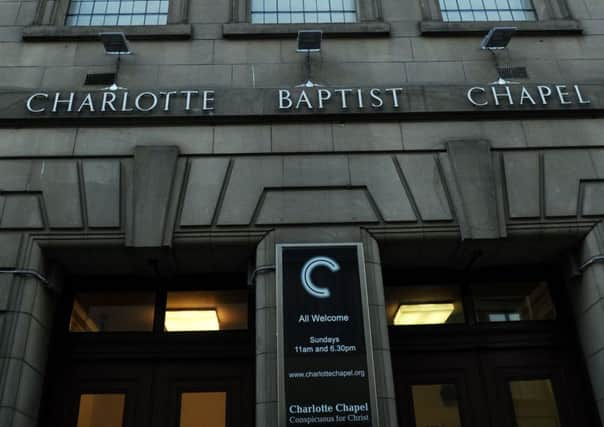Blooming Rose Street venue that could transform Edinburgh's arts scene


The Traverse Theatre, Summerhall, the Fringe, the Edinburgh International Festival itself: it’s a strange truth about Edinburgh that for all the painstaking debate about arts policy that often takes place in the city, some of the greatest developments in our cultural life seem to arrive out of the blue, like sudden, unexpected gifts.
And now, it looks as though that kind of magic may be about to happen again; for last month, without fanfare, the great international dancer and choreographer Peter Schaufuss – a veteran of many Edinburgh Festivals, and a former director of English National Ballet, among other companies – won planning permission to transform the Charlotte Baptist Chapel in Rose Street, one of the iconic public buildings of the New Town, into a year-round mid-scale dance and theatre venue. “It is impossible not to wonder at the vision of the men who commissioned and designed this building,” wrote Schaufuss in his vision statement to Edinburgh City Council. “I also have a vision for Charlotte Chapel and Edinburgh, one that I hope will cement its future for many future generations by fully utilising its potential, while keeping and maintaining its precious architectural heritage.” The proposal has attracted support from leading theatre figures, including Darcey Bussell, Felicity Kendal, and the producer Nica Burns.
Advertisement
Hide AdThe winning of planning permission is of course only the first step in the possible development of the proposed “Rose Theatre”; but with Schaufuss prepared to put £1.8 million of personal resources into the immediate purchase and conversion of the building, exciting plans have already been drawn up, showing a “black box” experimental theatre in the basement, a rehearsal room-cum-studio theatre on the top floor, and in between – in the main space on the first and second floors – a theatre that would vary in size from 210 seats to 620, depending on configuration, and that might, over a year, attract well over 100,000 theatregoers, and add more than £3.5 million to the local economy. Schaufuss has undertaken to programme at least 22 full-evening productions a year in the venue, and to make it a UK home for his own dance company, based in Holstebro, Denmark. He also intends to run an extensive programme of classes, workshops, and community days, along with an apprenticeship scheme, and to offer free tickets to schoolchildren and pensioners.
“When I first heard of this project, it seemed almost too good to be true,” says Councillor Richard Lewis, Convener of Edinburgh City Council’s Culture and Sport Committee. “It’s so rare, in this position, to come across a project that doesn’t involve any request for funding, and of course given the current financial constraints, we just wouldn’t be able to consider opening a new venue on any other basis.
“It’s long been recognised, though, that Edinburgh is in real need of a mid-scale city centre venue like this. Our theatre landscape is divided between very large venues like the Playhouse, the Festival Theatre and the King’s, and fairly small ones, ranging downward in size from the Traverse, which has 250 seats in its main auditorium. The Lyceum and the Queen’s Hall, which are in the mid-scale, have their own programmes of music, and in-house theatre production.
“And that means that in both dance and theatre, Edinburgh is missing out on mid-scale touring productions of tremendous quality, that the city needs to see. So it seems as clear as it can be that there would be an enthusiastic Edinburgh audience for the kind of dance-based international programme Peter Schaufuss is offering, and for a space which could also provide a home for touring theatre on that scale.”
The new plans for the Charlotte Chapel also emphasise, once again, the role the arts can play in offering a new future to listed buildings created to house civic, religious or educational gatherings – buildings which are difficult to convert for hotel or residential use without damaging their essential shape and fabric. The long-running debate over the future of the old Royal High School reflects the same dilemma, with St Mary’s Music School now proposing the development of the building as a school and concert hall, rather than a hotel. And the new theatre scheme’s success in winning planning approval reflects the minimal changes it will involve to the building’s listed interior, which dates from 1908. The plan mainly involves the removal of a rear staircase to provide lift access, the installation of carefully designed lighting and technical equipment, the development of a completely removable temporary stage which will make it possible to reshape the main theatre into a thrust or transverse configuration, and the conversion of the chapel’s downstairs lounge into a bar, cafe and box office.
“What Peter Schaufuss brings to this project is a terrific combination of qualities,” says Lewis, himself a professional musician and composer who has worked in theatres across Europe. “He has the vision, the artistic track record, the resources and the experience, combined with a great love of Edinburgh. Given the times we live in, I could have been looking back on a period as Convener of Culture and Sport when we could contribute to consultative processes like the Desire Lines project, and Live Music Matters, and the new Cultural Working Group we’ve just set up to take forward some of those ideas, but we couldn’t really do anything to develop the city’s physical arts infrastructure.
Advertisement
Hide Ad“Now, though, it looks as if that may change. So yes, the possibility of a new theatre in Rose Street does feel like a gift; and all I can do is wish Peter Schaufuss every success, in making his vision a reality.”